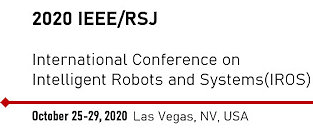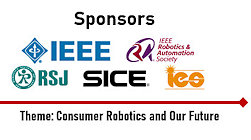




 |
Technical Program for Monday October 26, 2020 |
Open all abstracts Close all abstracts |
| MoOS | Room T24 |
| Opening | Opening Ceremony |
| Chair: Oh, Paul Y. | University of Nevada, Las Vegas (UNLV) |
| Co-Chair: O'Malley, Marcia | Rice University |
| 08:45-09:00, Paper MoOS.1 | |
| IROS Welcome Session | |
| Oh, Paul Y. | University of Nevada, Las Vegas (UNLV) |
| O'Malley, Marcia | Rice University |
| MoPL | Room T25 |
| Plenary 1 | Plenary session |
| Chair: Oh, Paul Y. | University of Nevada, Las Vegas (UNLV) |
| Co-Chair: O'Malley, Marcia | Rice University |
| 09:00-10:00, Paper MoPL.1 | |
| Robotics and AI for the Fashion Industry | |
| Kragic, Danica | KTH |
| MoBT2 | Room T2 |
| Marine Robotics: Mechanisms | Regular session |
| Chair: Sattar, Junaed | University of Minnesota |
| Co-Chair: Qian, Huihuan (Alex) | The Chinese University of Hong Kong, Shenzhen |
| 11:45-12:00, Paper MoBT2.1 | |
 Video Attachment Video Attachment | |
| Wang, Wei | Massachusetts Institute of Technology |
| Shan, Tixiao | Massachusetts Institute of Technology |
| Leoni, Pietro | Massachusetts Institute of Technology |
| Meyers, Drew | MIT |
| Ratti, Carlo | Massachusetts Institute of Technology |
| Rus, Daniela | MIT |
| 12:00-12:15, Paper MoBT2.2 | |
 Video Attachment Video Attachment | |
| Xue, Kaiwen | The Chinese University of Hong Kong, Shenzhen |
| Liu, Chongfeng | The Chinese University of Hong Kong, Shenzhen |
| Liu, Hengli | Peng Cheng Laboratory, Shenzhen |
| Xu, Ruoyu | The Chinese University of Hong Kong, Shenzhen |
| Sun, Zhenglong | Chinese University of Hong Kong, Shenzhen |
| Lam, Tin Lun | The Chinese University of Hong Kong, Shenzhen |
| Qian, Huihuan | Shenzhen Institute of Artificial Intelligence and Robotics for S |
| 12:15-12:30, Paper MoBT2.3 | |
| Suarez Fernandez, Ramon A. | Universidad Politecnica De Madrid |
| Grande, Davide | Politecnico Di Milano |
| Martins, Alfredo | INESC TEC |
| Bascetta, Luca | Politecnico Di Milano |
| Dominguez, Sergio | Technical University of Madrid |
| Rossi, Claudio | Universidad Politecnica De Madrid |
| 12:30-12:45, Paper MoBT2.4 | |
 Video Attachment Video Attachment | |
| Edge, Chelsey | University of Minnesota |
| Enan, Sadman Sakib | University of Minnesota, Twin Cities |
| Fulton, Michael | University of Minnesota |
| Hong, Jungseok | University of Minnesota |
| Mo, Jiawei | University of Minnesota, Twin Cities |
| Barthelemy, Kimberly | University of Minnesota |
| Bashaw, Hunter | Clarkson University |
| Kallevig, Berik | University of Minnesota Twin Cities |
| Knutson, Corey | University of Minnesota - Duluth |
| Orpen, Kevin | University of Minnesota |
| Sattar, Junaed | University of Minnesota |
| MoBT7 | Room T7 |
| Space Robotics: Systems | Regular session |
| Chair: Komendera, Erik | Virginia Polytechnic Institute and State University |
| Co-Chair: Kubota, Takashi | JAXA ISAS |
| 11:45-12:00, Paper MoBT7.1 | |
 Video Attachment Video Attachment | |
| Kato, Hiroki | Japan Aerospace Exploration Agency |
| Satou, Yasutaka | JAXA |
| Yoshikawa, Kent | JAXA |
| Otsuki, Masatsugu | Japan Aerospace Exploration Agency |
| Sawada, Hirotaka | JAXA |
| Kuratoi, Takeshi | WEL Research |
| Hidaka, Nana | WEL Research |
| 12:00-12:15, Paper MoBT7.2 | |
 Video Attachment Video Attachment | |
| Carroll, Devin | University of Pennsylvania |
| Yim, Mark | University of Pennsylvania |
| 12:15-12:30, Paper MoBT7.3 | |
 Video Attachment Video Attachment | |
| Reid, William | Jet Propulsion Laboratory |
| Paton, Michael | Jet Propulsion Laboratory |
| Karumanchi, Sisir | Jet Propulsion Lab, Caltech |
| Emanuel, Blair | Jet Propulsion Laboratory |
| Chamberlain-Simon, Brendan | Jet Propulsion Laboratory |
| Meirion-Griffith, Gareth | Jet Propulsion Laboratory |
| 12:30-12:45, Paper MoBT7.4 | |
| Everson, Holly | Virginia Polytechnic Institute and State University |
| Moser, Joshua | Virginia Polytechnic Institute and State University |
| Quartaro, Amy | Virginia Polytechnic Institute and State University |
| Glassner, Samantha | Virginia Tech |
| Komendera, Erik | Virginia Polytechnic Institute and State University |
| 12:45-13:00, Paper MoBT7.5 | |
 Video Attachment Video Attachment | |
| Schuster, Martin J. | German Aerospace Center (DLR) |
| Müller, Marcus Gerhard | German Aerospace Center |
| Brunner, Sebastian Georg | DLR German Aerospace Center, Robotics and Mechatronics Center |
| Lehner, Hannah | German Aerospace Center (DLR) |
| Lehner, Peter | German Aerospace Center (DLR) |
| Sakagami, Ryo | German Aerospace Center (DLR) |
| Dömel, Andreas | German Aerospace Center (DLR) |
| Meyer, Lukas | German Aerospace Center (DLR) |
| Vodermayer, Bernhard | German Aerospace Center (DLR) |
| Giubilato, Riccardo | German Aerospace Center (DLR) |
| Vayugundla, Mallikarjuna | DLR (German Aerospace Center) |
| Reill, Joseph | German Aerospace Center (DLR) |
| Steidle, Florian | German Aerospace Center |
| von Bargen, Ingo | German Aerospace Center (DLR) |
| Bussmann, Kristin | German Aerospace Center (DLR) |
| Belder, Rico | German Aerospace Center |
| Lutz, Philipp | German Aerospace Center (DLR) |
| Stuerzl, Wolfgang | DLR, Institute of Robotics and Mechantronics |
| Smisek, Michal | German Aerospace Center (DLR) |
| Maier, Moritz | German Aerospace Center (DLR) |
| Stoneman, Samantha | DLR (German Space Center) |
| Fonseca Prince, Andre | German Aerospace Center (DLR) |
| Rebele, Bernhard | German Aerospace Center (DLR) |
| Durner, Maximilian | German Aerospace Center DLR |
| Staudinger, Emanuel | DLR |
| Zhang, Siwei | German Aerospace Center (DLR) |
| Pöhlmann, Robert | German Aerospace Center (DLR) |
| Bischoff, Esther | Karlsruhe Institute of Technology (KIT) |
| Braun, Christian | Karlsruhe Institute of Technology (KIT) |
| Schröder, Susanne | German Aerospace Center (DLR) |
| Dietz, Enrico | German Aerospace Center (DLR) |
| Frohmann, Sven | German Aerospace Center (DLR) |
| Börner, Anko | DLR |
| Hübers, Heinz-Wilhelm | German Aerospace Center (DLR) |
| Foing, Bernard | European Space Agency (ESA) |
| Triebel, Rudolph | German Aerospace Center (DLR) |
| Albu-Schäffer, Alin | DLR - German Aerospace Center |
| Wedler, Armin | DLR - German Aerospace Center |
| 13:00-13:15, Paper MoBT7.6 | |
 Video Attachment Video Attachment | |
| Sakamoto, Takuma | The University of Tokyo |
| Bonardi, Stephane | Institute of Space and Astronautical Science (ISAS), Japan Aeros |
| Kubota, Takashi | JAXA ISAS |
| MoBT20 | Room T20 |
| IROS Original Series | Special Forum |
| Chair: Hauert, Sabine | University of Bristol |
| 11:45-12:00, Paper MoBT20.1 | |
| Real Roboticist - Michelle Johnson - Robots That Matter | |
| Hauert, Sabine | University of Bristol |
| 12:00-12:15, Paper MoBT20.2 | |
| Real Roboticist - Davide Scaramuzza - Drones & Magic | |
| Hauert, Sabine | University of Bristol |
| 12:15-12:30, Paper MoBT20.3 | |
| Real Roboticist - Dennis Hong - Making People Happy | |
| Hauert, Sabine | University of Bristol |
| 12:30-12:45, Paper MoBT20.4 | |
| Real Roboticist - Ruzena Bajczy - Foundations | |
| Hauert, Sabine | University of Bristol |
| 12:45-13:00, Paper MoBT20.5 | |
| Real Roboticist - Peter Corke - Learning | |
| Hauert, Sabine | University of Bristol |
| MoBT21 | Room T21 |
| BiR-IROS: Black in Robotics IROS 2020 | Special Forum |
| Chair: Howard, Ayanna | Georgia Institute of Technology |
| 11:45-12:00, Paper MoBT21.1 | |
| BiR-IROS Launch Event | |
| Howard, Ayanna | Georgia Institute of Technology |
| 12:00-12:15, Paper MoBT21.2 | |
| BiR Student Event | |
| Howard, Ayanna | Georgia Institute of Technology |
| 12:15-12:30, Paper MoBT21.3 | |
| BiR Allies Engagement Event | |
| Howard, Ayanna | Georgia Institute of Technology |
| MoBT22 | Room T22 |
| Cynthia Breazeal - Supplemental Videos | Special Forum |
| Chair: Oh, Paul Y. | University of Nevada, Las Vegas (UNLV) |
| 11:45-12:00, Paper MoBT22.1 | |
| Cynthia Breazeal - Supplemental Video 1 | |
| Breazeal, Cynthia | MIT |
| 12:00-12:15, Paper MoBT22.2 | |
| Cynthia Breazeal - Supplemental Video 2 | |
| Breazeal, Cynthia | MIT |
| 12:15-12:30, Paper MoBT22.3 | |
| Cynthia Breazeal - Supplemental Video 3 | |
| Breazeal, Cynthia | MIT |
| 12:30-12:45, Paper MoBT22.4 | |
| Cynthia Breazeal - Supplemental Video 4 | |
| Breazeal, Cynthia | MIT |
| 12:45-13:00, Paper MoBT22.5 | |
| Cynthia Breazeal - Supplemental Video 5 | |
| Breazeal, Cynthia | MIT |
| 13:00-13:15, Paper MoBT22.6 | |
| Cynthia Breazeal - Supplemental Video 6 | |
| Breazeal, Cynthia | MIT |
| MoCT17 | Room T17 |
| Surgical Robotics: Laparoscopy | Regular session |
| Chair: Kim, Keri | Korea Institute of Science and Technology |
| Co-Chair: Drake, James | Hospital for Sick Children, University of Toronto |
| 14:00-14:15, Paper MoCT17.1 | |
| Ohara, Mutsuki | Waseda University |
| Sanpei, Sohta | Waseda University |
| Seo, Chanjin | Waseda University |
| Ohya, Jun | Waseda University |
| Masamune, Ken | Tokyo Women's Medical University |
| Nagahashi, Hiroshi | Tokyo Institute of Technology |
| Morimoto, Yuji | National Defense Medical College |
| Harada, Manabu | National Defense Medical College |
| 14:15-14:30, Paper MoCT17.2 | |
 Video Attachment Video Attachment | |
| Kim, Jongwoo | The Hospital for Sick Children, University of Toronto |
| Looi, Thomas | Hospital for Sick Children |
| Newman, Allen | University of Toronto |
| Drake, James | Hospital for Sick Children, University of Toronto |
| 14:30-14:45, Paper MoCT17.3 | |
| Kim, Jeongryul | Korea Institute of Science and Technology |
| Moon, Yonghwan | Korea Institute of Science and Technology |
| Kwon, Seong-il | Korea Institute of Science and Technology |
| Kim, Keri | Korea Institute of Science and Technology |
| 14:45-15:00, Paper MoCT17.4 | |
| Bombieri, Marco | University of Verona |
| Dall'Alba, Diego | University of Verona |
| Ramesh, Sanat | University of Verona |
| Menegozzo, Giovanni | University of Verona |
| Schneider, Caitlin | University of British Columbia |
| Fiorini, Paolo | University of Verona |
| 15:00-15:15, Paper MoCT17.5 | |
 Video Attachment Video Attachment | |
| Ferraguti, Federica | Universitŕ Degli Studi Di Modena E Reggio Emilia |
| Minelli, Marco | University of Modena and Reggio Emilia |
| Farsoni, Saverio | University of Ferrara |
| Bazzani, Stefano | University of Modena and Reggio Emilia |
| Bonfe, Marcello | University of Ferrara |
| Vandanjon, Alexandre | Icam - Institut Catholique d’Arts Et M´etiers, France |
| Puliatti, Stefano | University of Modena and Reggio Emilia |
| Bianchi, Giampaolo | University of Modena and Reggio Emilia |
| Secchi, Cristian | Univ. of Modena & Reggio Emilia |
| MoKN1 | Room T27 |
| Keynote 1 | Keynote session |
| Chair: Oh, Paul Y. | University of Nevada, Las Vegas (UNLV) |
| Co-Chair: O'Malley, Marcia | Rice University |
| 15:45-16:30, Paper MoKN1.1 | |
| Perception in Aerial, Marine and Space Robotics: A Biased Outlook | |
| Dellaert, Frank | Georgia Institute of Technology |
| MoKN2 | Room T24 |
| Keynote 2 | Keynote session |
| Chair: Oh, Paul Y. | University of Nevada, Las Vegas (UNLV) |
| Co-Chair: O'Malley, Marcia | Rice University |
| 15:45-16:30, Paper MoKN2.1 | |
| Design Contact Dynamics in Advance - Integrate Hardware Dynamics and Control | |
| Hurst, Jonathan | Oregon State University |
| MoKN3 | Room T24 |
| Keynote 3 | Keynote session |
| Chair: Oh, Paul Y. | University of Nevada, Las Vegas (UNLV) |
| Co-Chair: O'Malley, Marcia | Rice University |
| 15:45-16:30, Paper MoKN3.1 | |
| Automation of Food Handling: From Item-Picking to Food-Picking | |
| Chen, I-Ming | Nanyang Technological University |
| MoKN4 | Room T24 |
| Keynote 4 | Keynote session |
| Chair: Oh, Paul Y. | University of Nevada, Las Vegas (UNLV) |
| Co-Chair: O'Malley, Marcia | Rice University |
| 15:45-16:30, Paper MoKN4.1 | |
| Rapidly Exploring Random Topics | |
| LaValle, Steven M | University of Oulu |